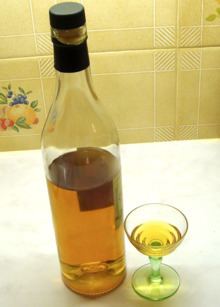 | ||
Similar Grappa, Eau de vie, Calvados, Armagnac, Aguardiente | ||
Pomace brandy, also called marc in both English and French, is a liquor distilled from pomace that is left over from winemaking after the grapes are pressed. Alcohol derived from pomace is also used as the traditional base spirit of other liquors, such as some anise-flavored spirits. Unlike wine brandy, most pomace brandies are neither aged nor coloured.
Contents
Production
Pomace may be either fermented, semi-fermented, or unfermented. During red wine vinification, the pomace is left to soak in the must for the entire fermentation period and is thus fermented. Fermented pomace is particularly suitable for the production of pomace brandy, as it is soft, dry, and has a high alcohol content. Semi-fermented pomace is produced during rosé wine vinification, where the pomace is removed before fermentation is complete. Virgin pomace, which is produced during white wine vinification, is not fermented at all.
Both semi-fermented and unfermented pomace must be kept in a silo until fermentation is complete. After fermentation is complete, the pomace is distilled.
Varieties
Varieties of pomace brandy include:
